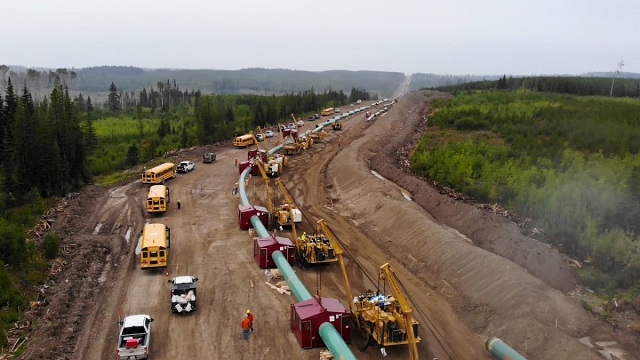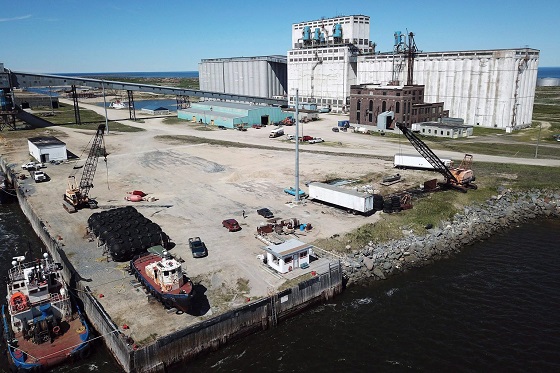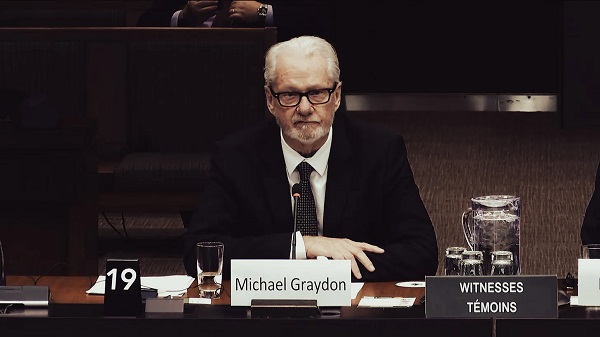Economy
Trudeau’s Economic Mismanagement Exposed: GDP Report Reveals Alarming Decline in Canadian Prosperity

The latest “Gross Domestic Product, Income, and Expenditure: Third Quarter 2024” report highlights six consecutive declines in GDP per capita & collapsing business investment
Good evening my fellow Canadians, and welcome to the final chapter of Canada as a thriving economy, brought to you courtesy of Justin Trudeau. The latest GDP report isn’t just a spreadsheet of bad news—it’s a grim look at the devastation Trudeau has unleashed on Canada’s economy.
Here’s what they won’t tell you: while Trudeau prances around on the world stage, preaching about climate change and “equity,” the average Canadian is getting poorer. GDP per capita—one of the most telling measures of prosperity—has now declined for six consecutive quarters, hitting levels not seen since 2017. Let that sink in. Under Trudeau’s leadership, Canadians are worse off today than they were seven years ago.
Canada’s GDP Growth: A Sluggish Economy Falling Behind
The latest figures from Statistics Canada’s Gross Domestic Product, Income, and Expenditure: Third Quarter 2024 report show an economy struggling to find its footing. Real GDP grew by 0.3% in Q3 2024, a slowdown from the 0.5% growth in the first and second quarters of the year. On an annual basis, GDP growth for 2023 was a modest 1.1%, further highlighting Canada’s weak economic momentum.
In real terms, Canada’s GDP as of Q3 2024 stands at $2,419,572 million (chained 2017 dollars). While the economy continues to expand, this growth pales in comparison to the nation’s surging population.
GDP Per Capita Declines: A Warning Sign for Canadians
Canada’s economic growth is not keeping pace with its rapid population expansion. In Q3 2024, GDP per capita—arguably the most important measure of economic health—declined by 0.4%, marking the sixth consecutive quarterly drop. With a staggering 3.2% population growth in 2023, Canada’s economy cannot sustain the same level of prosperity for its citizens.
Current GDP per capita is estimated at ~$54,000, down from its pre-pandemic high of ~$58,100 in 2017, and 2.5% below 2019 levels. To return to its long-term trend, GDP per capita would need to grow at an ambitious 1.7% annually for the next decade, a rate well above the recent average of just 1.1% per year since 1981.
Historical Context: Long-Term Prosperity Eroded
The report shows a troubling trajectory in inflation-adjusted GDP per capita over decades:
- 1981: ~$36,900
- 2017: ~$58,100
- 2024: ~$54,000 (estimated due to consecutive declines).
Despite Canada’s resource wealth and economic potential, GDP per capita remains 7% below its historical growth trend, signaling systemic productivity and investment issues.
Key Drivers of GDP Growth in Q3 2024
The Q3 2024 report highlights the components influencing GDP growth:
- Household Spending: +0.9%
- Government Spending: +1.1%
- Business Investment in Machinery and Equipment: -7.8%
- Exports: -0.3%
- Imports: -0.1%
While household and government expenditures provided some lift, the steep decline in business investment—down nearly 8%—and weaker exports reveal structural weaknesses in Canada’s economic model.
A Warning for the Future
These numbers tell a grim story: Canada’s economic growth, when adjusted for its population explosion, is failing to provide real benefits to its citizens. GDP per capita declines, stagnant productivity, and plummeting business investment highlight the challenges ahead. Without dramatic improvements in productivity, competitiveness, and fiscal policy, Canada’s long-term economic prospects remain precarious.
Trudeau’s Population Bomb
In 2023, Canada’s population grew by a jaw-dropping 3.2%, adding over 1.27 million people—the size of Calgary—in just one year. Trudeau’s open-door immigration policy is out of control. But here’s the kicker: the economy isn’t keeping up. GDP growth is crawling at 0.3%, while GDP per capita—the number that actually reflects living standards—has fallen 2.5% below pre-pandemic levels.
What does this mean? Trudeau is creating a country where there are more people, but less wealth to go around. He’s importing voters for his political base while ignoring the basic economics of supply and demand. More people mean more pressure on housing, healthcare, and infrastructure—all of which are already in crisis. Trudeau gets the photo ops, and Canadians get poorer.
Productivity? What’s That?
Here’s the real scandal: Canada’s productivity is collapsing, and Trudeau couldn’t care less. Business investment in machinery and equipment—a cornerstone of economic growth—dropped 7.8% in Q3 2024. That’s not a blip. It’s part of a long-term trend.
Under Trudeau, Canada has become hostile to business. With punishing taxes, endless red tape, and policies designed to appease radical activists, companies have stopped investing. They’re pulling back because they see no future in a country run by a trust-fund prime minister who treats the economy like his personal virtue-signaling playground.
Exports Collapse, Government Spending Soars
Exports fell 0.3% this quarter, after a 1.4% drop the quarter before. That’s Canada losing its competitive edge, plain and simple. While Trudeau waxes poetic about “green transitions,” other countries are eating Canada’s lunch.
Meanwhile, Trudeau’s solution to every problem is predictable: throw money at it. Government spending rose 1.1% in Q3 2024, marking the third consecutive quarterly increase. But this isn’t investment—it’s waste. It’s billions spent on flashy programs that do nothing to address Canada’s fundamental economic problems.
The OECD Warning Trudeau Ignores
Here’s a fact Trudeau won’t tweet about: The Organization for Economic Co-operation and Development (OECD) projects that Canada will have the lowest GDP per capita growth of all member countries through 2060. That’s Trudeau’s legacy: turning Canada into the slowest-growing economy in the developed world.
This isn’t just incompetence—it’s deliberate. Trudeau’s agenda isn’t about making Canada prosperous; it’s about centralizing power. His policies crush the middle class, drive businesses out, and create dependence on government handouts.
The Final Verdict
Justin Trudeau has managed to take one of the most resource-rich, opportunity-filled countries in the world and drive it into economic stagnation. He’s turned Canada into a welfare state for the many and a playground for the elite. GDP per capita is falling, productivity is collapsing, and the future looks bleak for ordinary Canadians.
Let’s be clear: Trudeau doesn’t care. As long as he’s jet-setting to global conferences, virtue-signaling about climate justice, and securing his legacy as the darling of the global elite, the suffering of everyday Canadians is irrelevant to him.
Canada deserves better. It deserves leadership that values hard work, economic freedom, and the dignity of a prosperous nation. And until Trudeau is gone, don’t expect any of that.
Subscribe to The Opposition with Dan Knight .
For the full experience, upgrade your subscription.
Business
Large-scale energy investments remain a pipe dream

I view the recent announcements by the Government of Canada as window dressing, and not addressing the fundamental issue which is that projects are drowning in bureaucratic red tape and regulatory overburden. We don’t need them picking winners and losers, a fool’s errand in my opinion, but rather make it easier to do business within Canada and stop the hemorrhaging of Foreign Direct Investment from this country.
Thanks for reading William’s Substack!
Subscribe for free to receive new posts and support my work.
Changes are afoot—reportedly, carve-outs and tweaks to federal regulations that would help attract investment in a new oil pipeline from Alberta. But any private proponent to come out of this deal will presumably be handpicked to advance through the narrow Bill C-5 window, aided by one-off fixes and exemptions.
That approach can only move us so far. It doesn’t address the underlying problem.
Anyone in the investment world will tell you a patchwork of adjustments is nowhere near enough to unlock the large-scale energy investment this country needs. And from that investor’s perspective, the horizon stretches far beyond a single political cycle. Even if this government promises clarity today in the much-anticipated memorandum of understanding (MOU), who knows whether it will be around by the time any major proposal actually moves forward.
With all of the talk of “nation-building” projects, I have often been asked what my thoughts are about what we must see from the federal government.
The energy sector is the file the feds have to get right. It is by far the largest component of Canadian exports, with oil accounting for $147 billion in 2024 (20 percent of all exports), and energy as a whole accounting for $227 billion of exports (30 percent of all exports).
Furthermore, we are home to some of the largest resource reserves in the world, including oil (third-largest in proven reserves) and natural gas (ninth-largest). Canada needs to wholeheartedly embrace that. Natural resource exceptionalism is exactly what Canada is, and we should be proud of it.
One of the most important factors that drives investment is commodity prices. But that is set by market forces.
Beyond that, I have always said that the two most important things one considers before looking at a project are the rule of law and regulatory certainty.
The Liberal government has been obtuse when it comes to whether it will continue the West Coast tanker ban (Bill C-48) or lift it to make way for a pipeline. But nobody will propose a pipeline without the regulatory and legal certainty that they will not be seriously hindered should they propose to build one.
Meanwhile, the proposed emissions cap is something that sets an incredibly negative tone, a sentiment that is the most influential factor in ensuring funds flow. Finally, the Impact Assessment Act, often referred to as the “no more pipelines bill” (Bill C-69), has started to blur the lines between provincial and federal authority.
All three are supposedly on the table for tweaks or carve-outs. But that may not be enough.
It is interesting that Norway—a country that built its wealth on oil and natural gas—has adopted the mantra that as long as oil is a part of the global economy, it will be the last producer standing. It does so while marrying conventional energy with lower-carbon standards. We should be more like Norway.
Rather than constantly speaking down to the sector, the Canadian government should embrace the wealth that this represents and adopt a similar narrative.
The sector isn’t looking for handouts. Rather, it is looking for certainty, and a government proud of the work that they do and is willing to say so to Canada and the rest of the world. Foreign direct investment outflows have been a huge issue for Canada, and one of the bigger drags on our economy.
Almost all of the major project announcements Prime Minister Mark Carney has made to date have been about existing projects, often decades in the making, which are not really “additive” to the economy and are reflective of the regulatory overburden that industry faces en masse.
I have always said governments are about setting the rules of the game, while it is up to businesses to decide whether they wish to participate or to pick up the ball and look elsewhere.
Capital is mobile and will pursue the best risk-adjusted returns it can find. But the flow of capital from our country proves that Canada is viewed as just too risky for investors.
The government’s job is not to try to pick winners and losers. History has shown that governments are horrible at that. Rather, it should create a risk-appropriate environment with stable and capital-attractive rules in place, and then get out of the way and see where the chips fall.
Link to The Hub article: Large-scale energy investments remain a pipe dream
Formerly the head of institutional equity research at FirstEnergy Capital Corp and ATB Capital Markets. I have been involved in the energy sector in either the sell side or corporately for over 25 years
Thanks for reading William’s Substack!
Subscribe for free to receive new posts and support my work.
Business
Will the Port of Churchill ever cease to be a dream?

From Resource Works
The Port of Churchill has long been viewed as Canada’s northern gateway to global markets, but decades of under-investment have held it back.
A national dream that never materialised
For nearly a century, Churchill, Manitoba has loomed in the national imagination. In 1931, crowds on the rocky shore watched the first steamships pull into Canada’s new deepwater Arctic port, hailed as the “thriving seaport of the Prairies” that would bring western grain “1,000 miles nearer” to European markets. The dream was that this Hudson Bay town would become a great Canadian centre of trade and commerce.
The Hudson Bay Railway was blasted across muskeg and permafrost to reach what engineers called an “incomparably superior” harbour. But a short ice free season and high costs meant Churchill never grew beyond a niche outlet beside Canada’s larger ports, and the town’s population shrank.
False starts, failed investments
In 1997, Denver based OmniTrax bought the port and 900 kilometre rail line with federal backing and promises of heavy investment. Former employees and federal records later suggested those promises were not fully kept, even as Ottawa poured money into the route and subsidies were offered to keep grain moving north. After port fees jumped and the Canadian Wheat Board disappeared, grain volumes collapsed and the port shut, cutting rail service and leaving northern communities and miners scrambling.
A new Indigenous-led revival — with limits
The current revival looks different. The port and railway are now owned by Arctic Gateway Group, a partnership of First Nations and northern municipalities that stepped in after washouts closed the line and OmniTrax walked away. Manitoba and Ottawa have committed $262.5 million over five years to stabilize the railway and upgrade the terminal, with Manitoba’s share now at $87.5 million after a new $51 million provincial pledge.
Prime Minister Mark Carney has folded Churchill into his wider push on “nation building” infrastructure. His government’s new Major Projects Office is advancing energy, mining and transmission proposals that Ottawa says add up to more than $116 billion in investment. Against that backdrop, Churchill’s slice looks modest, a necessary repair rather than a defining project.
The paperwork drives home the point. The first waves of formally fast tracked projects include LNG expansion at Kitimat, new nuclear at Darlington and copper and nickel mines. Churchill sits instead on the office’s list of “transformative strategies”, a roster of big ideas still awaiting detailed plans and costings, with a formal Port of Churchill Plus strategy not expected until the spring of 2026 under federal–provincial timelines.
Churchill as priority — or afterthought?
Premier Wab Kinew rejects the notion that Churchill is an afterthought. Standing with Carney in Winnipeg, he called the northern expansion “a major priority” for Manitoba and cast the project as a way for the province “to be able to play a role in building up Canada’s economy for the next stage of us pushing back against” U.S. protectionism. He has also cautioned that “when we’re thinking about a major piece of infrastructure, realistically, a five to 10 year timeline is probably realistic.”
On paper, the Port of Churchill Plus concept is sweeping. The project description calls for an upgraded railway, an all weather road, new icebreaking capacity in Hudson Bay and a northern “energy corridor” that could one day move liquefied natural gas, crude oil, electricity or hydrogen. Ottawa’s joint statement with Manitoba calls Churchill “without question, a core component to the prosperity of the country.”
Concepts without commitments
The vision is sweeping, yet most of this remains conceptual. Analysts note that hard questions about routing, engineering, environmental impacts and commercial demand still have to be answered. Transportation experts say they struggle to see a purely commercial case that would make Churchill more attractive than larger ports, arguing its real value is as an insurance policy for sovereignty and supply chain resilience.
That insurance argument is compelling in an era of geopolitical risk and heightened concern about Arctic security. It is also a reminder of how limited Canada’s ambition at Churchill has been. For a hundred years, governments have been willing to dream big in northern Manitoba, then content to underbuild and underdeliver, as the port’s own history of near misses shows. A port that should be a symbol of confidence in the North has spent most of its life as a seasonal outlet.
A Canadian pattern — high ambition, slow execution
The pattern is familiar across the country. Despite abundant resources, capital and engineering talent, mines, pipelines, ports and power lines take years longer to approve and build here than in competing jurisdictions. A tangle of overlapping regulations, court challenges and political caution has turned review into a slow moving veto, leaving a politics of grand announcements followed by small, incremental steps.
Churchill is where those national habits are most exposed. The latest round of investment, led by Indigenous owners and backed by both levels of government, deserves support, as does Kinew’s insistence that Churchill is a priority. But until Canada matches its Arctic trading rhetoric with a willingness to build at scale and at speed, the port will remain a powerful dream that never quite becomes a real gateway to the world.
Headline photo credit to THE CANADIAN PRESS/John Woods
-

 Energy2 days ago
Energy2 days agoExpanding Canadian energy production could help lower global emissions
-

 Business2 days ago
Business2 days agoWill the Port of Churchill ever cease to be a dream?
-

 COVID-191 day ago
COVID-191 day agoFreedom Convoy protestor Evan Blackman convicted at retrial even after original trial judge deemed him a “peacemaker”
-

 Daily Caller1 day ago
Daily Caller1 day agoTrump Gives Zelenskyy Until Thanksgiving To Agree On Peace Deal, With U.S. Weapons And Intel On The Line
-

 Daily Caller1 day ago
Daily Caller1 day agoBari Weiss Reportedly Planning To Blow Up Legacy Media Giant
-

 Business17 hours ago
Business17 hours agoI Was Hired To Root Out Bias At NIH. The Nation’s Health Research Agency Is Still Sick
-

 Business2 days ago
Business2 days agoThe numbers Canada uses to set policy don’t add up
-

 Business2 days ago
Business2 days agoNew airline compensation rules could threaten regional travel and push up ticket prices








